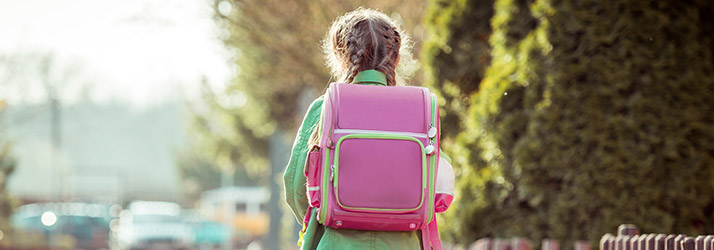Backpack Safety Tips; Volume 14 Issue 43
Backpack Safety Tips; Volume 14 Issue 43

The force on the spine from a heavy backpack causes muscle strain, distorts the natural curves of the spine and compresses the intervertebral discs, which are the shock absorbers of the spine. When a child's back pack is too heavy the child tends to lean forward which leads to rounded shoulders and an increased curve in their upper back. This increased curve may lead to compression of the spine. Often the children wear only one shoulder strap which strains the neck and shoulder muscles and creates imbalance in the spine.
Follow the guidelines below to insure a proper fit for your child's back pack:
- Personalize the backpack fit to your child. The back pack should be positioned about 2 inches below the shoulders and 2 inches above the hips. This may require adjusting the straps of the backpack to ensure a proper fit for your child. Many children wear their back pack really low. This leads to additional pressure on the shoulders and lower back. It also often causes the child to lean forward when walking causing additional stress on the spine.
- Use wide shouldered backpacks with a padded shoulder strap. A 2" wide strap or greater helps to distribute the weight of the backpack. This will also help to avoid the straps from digging into their shoulders which may lead to pressure on the nerves and poor circulation. This may lead to tingling and numbness in the arms and hands
- The backpack should be worn using both straps. Many students sling just one strap over their shoulder which causes a great deal of weight on the one shoulder and may lead to back problems. Based on a 2016 study in the Spine Journal wearing a backpack incorrectly is a major contributor of back -related injuries in children. To avoid this, advise your children to always wear the back pack on both shoulders to evenly distribute the weight. Furthermore, if the back pack has a waist and chest strap this will take additional pressure off the shoulders and redistribute it to the upper body.
- A backpack with a padded back is ideal to prevent the contents from inside from smacking against the child's back
- Compartments inside the backpack will allow the contents inside to be distributed more evenly
- The backpack should weigh no more than 10% of the child's body weight. For a preschooler that weighs 40 pounds that means the backpack and its contents should not exceed more than 4 pounds. You may want to get into a regular habit of cleaning out the backpack to prevent it from exceeding the 10% of your child's body weight. If the school allows a backpack with wheels you may go up to 20% of the child's body weight. Another way to lighten the load is to advise your children to only bring the books they are currently using to school in their back pack.
- When the child is standing for a long time, it is best to give the body a break and remove the backpack. If the child has to wait for the bus or a ride is best to remove the backpack while waiting. Therefore, it is best if you are able to purchase a self-standing back pack
OUR LOCATIONS:
Galloway
Egg Harbor Township
Atlantic City
Hammonton



